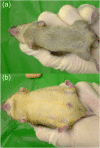Proopiomelanocortin (POMC) and psychodermatology
- PMID: 37275429
- PMCID: PMC10233089
- DOI: 10.1002/ski2.201
Proopiomelanocortin (POMC) and psychodermatology
Abstract
Psychodermatology is the crossover discipline between Dermatology and Clinical Psychology and/or Psychiatry. It encompasses both Psychiatric diseases that present with cutaneous manifestations (such as delusional infestation) or more commonly, the psychiatric or psychological problems associated with skin disease, such as depression associated with psoriasis. These problems may be the result either of imbalance in or be the consequence of alteration in the homoeostatic endocrine mechanisms found in the systemic hypothalamic-pituitary-adrenal axis or in the local cutaneous corticotrophin-releasing factor-proopiomelanocortin-corticosteroid axis. Alteration in either of these systems can lead to immune disruption and worsening of immune dermatoses and vice-versa. These include diseases such as psoriasis, atopic eczema, acne, alopecia areata, vitiligo and melasma, all of which are known to be linked to stress. Similarly, stress and illnesses such as depression are linked with many immunodermatoses and may reflect alterations in the body's central and peripheral neuroendocrine stress pathways. It is important to consider issues pertaining to skin of colour, particularly with pigmentary disorders.
© 2023 The Authors. Skin Health and Disease published by John Wiley & Sons Ltd on behalf of British Association of Dermatologists.
Conflict of interest statement
GWMM is the Editor‐in‐Chief of Skin Health and Disease.
Figures




Similar articles
-
Pruritus, Allergy and Autoimmunity: Paving the Way for an Integrated Understanding of Psychodermatological Diseases?Front Allergy. 2021 Sep 17;2:688999. doi: 10.3389/falgy.2021.688999. eCollection 2021. Front Allergy. 2021. PMID: 35387041 Free PMC article.
-
[PSYCHODERMATOLOGY].Acta Med Croatica. 2016;70 Suppl 1:35-8. Acta Med Croatica. 2016. PMID: 29087669 Review. Croatian.
-
[The role of psychological factors and psychiatric disorders in skin diseases].Med Pr. 2006;57(6):551-5. Med Pr. 2006. PMID: 17533993 Review. Polish.
-
Stress-induced Interaction of Skin Immune Cells, Hormones, and Neurotransmitters.Clin Ther. 2020 May;42(5):757-770. doi: 10.1016/j.clinthera.2020.03.008. Epub 2020 Apr 7. Clin Ther. 2020. PMID: 32276734 Review.
-
Psychological Morbidity in Chronic Dermatological Disorders: A Review.Indian Dermatol Online J. 2025 Apr 17;16(3):381-388. doi: 10.4103/idoj.idoj_458_24. eCollection 2025 May-Jun. Indian Dermatol Online J. 2025. PMID: 40395584 Free PMC article. Review.
Cited by
-
The Hormonal Background of Hair Loss in Non-Scarring Alopecias.Biomedicines. 2024 Feb 24;12(3):513. doi: 10.3390/biomedicines12030513. Biomedicines. 2024. PMID: 38540126 Free PMC article. Review.
-
CD44 signaling in skin wound healing and regeneration.J Transl Med. 2025 Aug 7;23(1):880. doi: 10.1186/s12967-025-06913-5. J Transl Med. 2025. PMID: 40775777 Free PMC article. Review.
-
Psychodermatology special edition.Skin Health Dis. 2022 Feb 14;2(2):e102. doi: 10.1002/ski2.102. eCollection 2022 Jun. Skin Health Dis. 2022. PMID: 35677924 Free PMC article. No abstract available.
-
Exploring the Relationship Between Psychiatric Illness and Dermatological Disorders: A Narrative Review.Cureus. 2025 Feb 8;17(2):e78731. doi: 10.7759/cureus.78731. eCollection 2025 Feb. Cureus. 2025. PMID: 40065888 Free PMC article. Review.
-
Neuro-immuno-endocrinology of the skin: how environment regulates body homeostasis.Nat Rev Endocrinol. 2025 Aug;21(8):495-509. doi: 10.1038/s41574-025-01107-x. Epub 2025 Apr 22. Nat Rev Endocrinol. 2025. PMID: 40263492 Review.
References
Publication types
LinkOut - more resources
Full Text Sources
Miscellaneous
